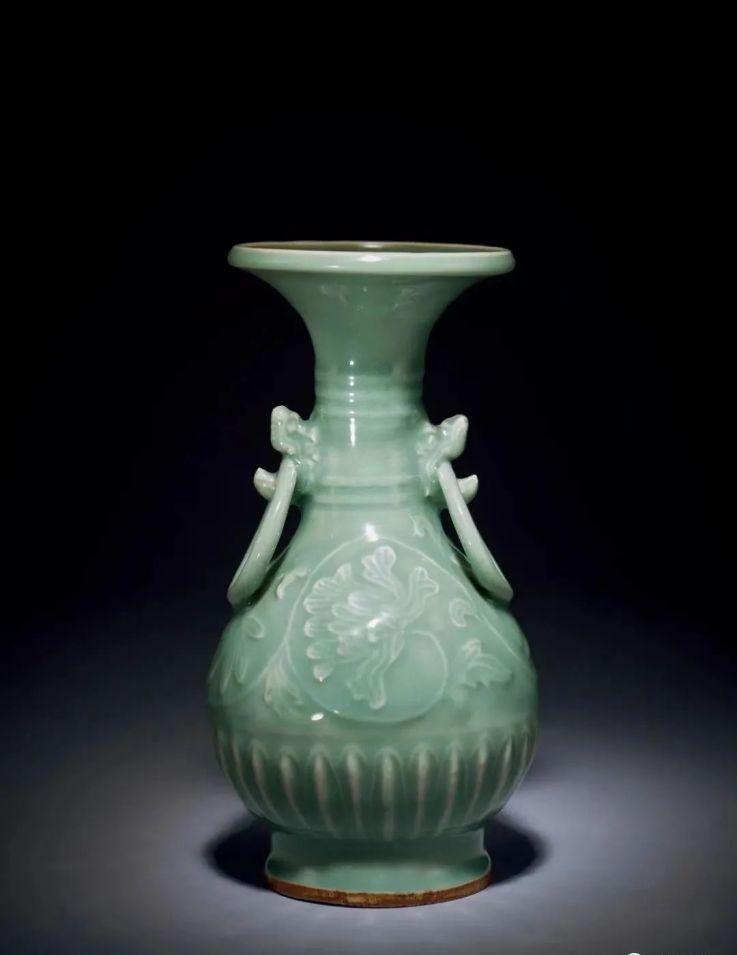Today, I want to talk about a piece of "Southern Song Dynasty-Yuan Longquan Blue Glazed Peony Pattern Double Dragon Ring Ear Bottle (Lot 1113)" in the special session of "Song Yuan, Ming, Qing, and Ya Yun Liu Zhen" in central Tokyo.
The special auction selects a total of 9 art treasures of the Song, Yuan, Ming and Qing dynasties as the finale of the year in Tokyo Chuo, which is also the last large-scale auction of the year in the entire auction market inside and outside the sea.
From the perspective of publicity, this ring ear bottle is informative, and specially invited experts in Japan to focus on the introduction, and the valuation is as high as 3.5 million to 5.5 million Hong Kong dollars (auctioned in Hong Kong, RMB: 2,975,000-4,675,000), second only to the same scene of "Qingqianlong porcelain tire Yangcai Yellow Tangled Lotus Lotus Lotus Eight Treasure Pattern Flower Yao (a pair)", which can be seen in the respect.

The special feature of this bottle is the cloud dragon pattern depicted in gold paint on the bottom.
I don't know whether it is a "congenital" kiln crack, or a crack during long-term use, the bottom has been repaired, and the repair traces are beautified with a cloud dragon pattern, which shows that the collector cherishes this bottle.
This bottle of glazed water is both well-shaped and exquisitely ornamented, but the purpose of this article is not to "overflow", but to feel the content of its promotion. This is also a common phenomenon in the promotion process of many lots, especially the Longquan celadon collection in Japan.
Boxed in a double-layered box with a sticker on the outside lid
Black lacquered inner box with tokugawa Mitsuhito's handwritten name
A sign for the collection of the Mano Museum
Publication catalogue
There is nothing wrong with vigorously promoting the packaging of a lot, and many large auction houses usually render them to the greatest extent in addition to the detailed interpretation of important lots, so that customers can "see the pearls". Like this ring ear bottle, it is placed in the historical and cultural background of Japan to promote, from the basic name interpretation to the circulation of collections, etc., it shows the imprint of Japanese history and culture, and what it presents is a rich Japanese style. As Chinese collectors, how do we view such collections?
The author believes that the bottle's "experience of staying in the ocean" is only one aspect. I have to admit that the Japanese like Longquan celadon and cherish Longquan celadon, like this kind of appliqué peony pattern amphora, in the minds of the Japanese, the status is indeed very high, because the grade of Longquan celadon in the Japanese tea ceremony itself is relatively high. I remember that two years ago, I visited a "Song Ci" exhibition at the Izumitsu Museum of Art in Japan, and one of the similar ring bottles was on the cover of the brochure.
(Photo taken at Izumitsu Museum)
This piece of glaze is also very good, and the snout earrings and peony pattern are slightly different from the central one in Tokyo.
Catalogue from the Nezu Museum
I have seen similar bottles many times in Japanese antique shops and some art museum catalogues, so I once speculated that such bottles may be exported to the Japanese market at that time.
At that time, the author also mentioned this phenomenon in the article (look at the Longquan kiln celadon and others in the Japanese collection), this kind of bottle is very popular in Japan, but it is not taken seriously in China.
Why? From our point of view, the Yuanming Longquan kiln amphora cylinder firing volume is large, and the specifications are very rich, as described in this article is only one of them. Among them, the use of appliqué peony pattern is not only this type of bottle, common in the Yuan Dynasty Longquan kiln furnace, lid jar, anchovy bottle and other instrument types. Due to the large total number of ring bottles, few fine products, and common products are mediocre, it is easy to cause the impression of "low character". That is to say, looking at the entire Longquan celadon variety, this kind of bottle does not appear prominent, so it is easy to be ignored.
Collection of Zhejiang Provincial Museum
The picture shows the collection of "Blue Out of Blue - The First Longquan Celadon Folk Collection Exhibition" held in Beijing Huaxia Antique City in 2017, which is a complete pair and a rare boutique such as ring bottle.
This type of ring bottle was originally a pair of ornaments, or can be used with a stove for three offerings.
Back to the point, how do we make our own value judgments? Is it "important and precious" because it was once an excellent flower entry (flower vessel) in the Japanese tea ceremony, and it was collected by Japanese feudal daimyōs and left authentic works (and identified by Japanese celebrities), or was it included in the category of Motomei Ryusen's ring bottles, and it was regarded by all?
In my opinion, none of this matters. I have always advocated the basis of utensils, returning to the utensils themselves, appreciating a piece of Longquan celadon, we should recognize from the essence of the glaze, and grasp the evaluation from the aspects of modeling and ornamentation. Whether the glaze water is pure, whether the proportion of the instrument shape is coordinated, whether the ornamentation is smooth and flexible, whether the process details are delicate and in place, and so on. Only in this way can we truly rely on our own level of appreciation to "discern the pearls", and it is not easy to be disturbed by other information.